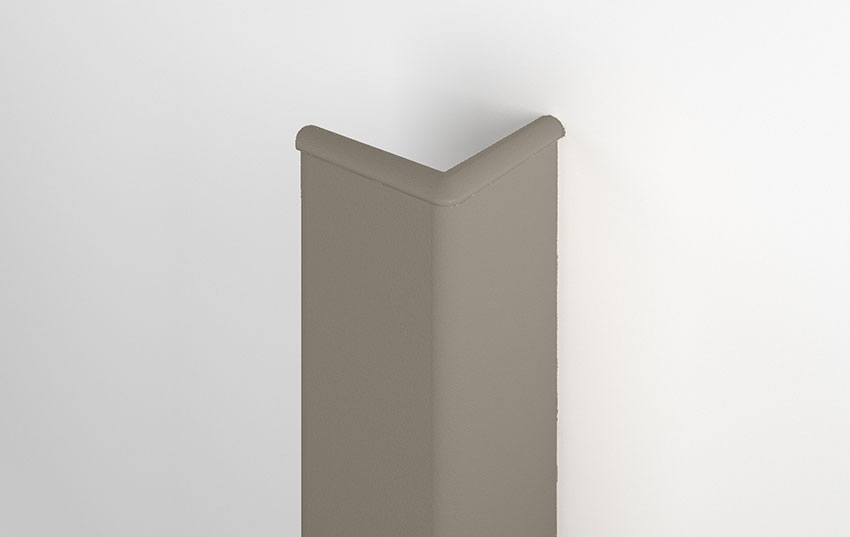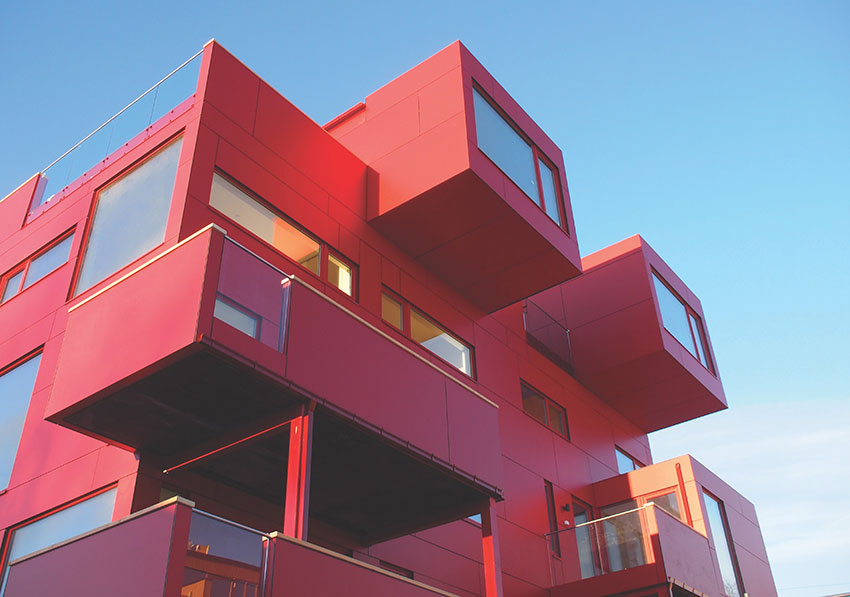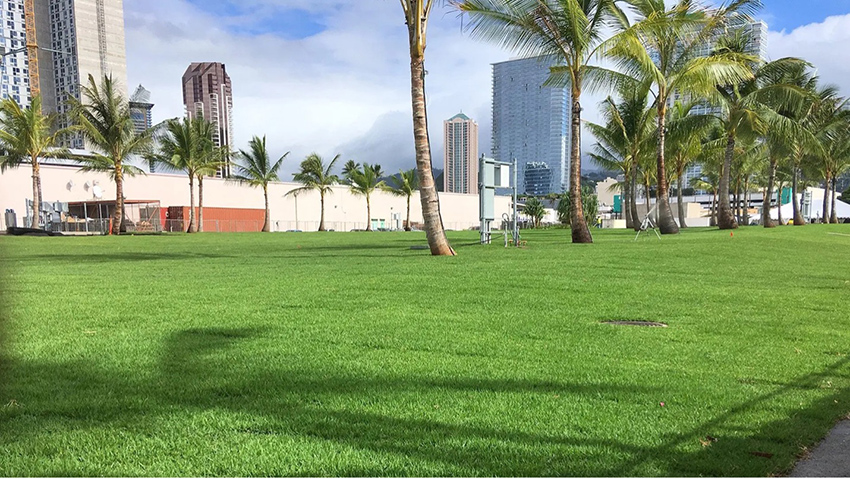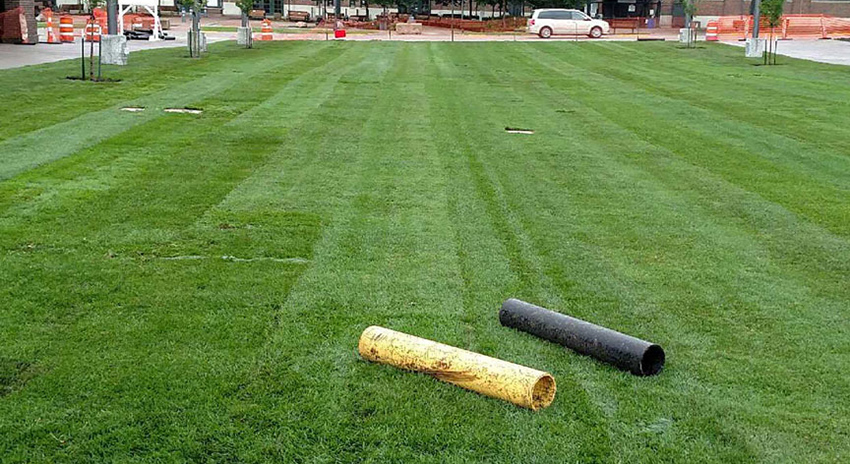Adventures at the New Frontier
The use, weight, and frequency of traffic determine what type of paver can be used. Permeable Pavers can be designed to host a wide range of traffic types; from pedestrian foot traffic, to residential parking, to emergency vehicles. The depth of the base course beneath the pavers determines the weight the pavers can support. With an appropriate base course, permeable pavers can far exceed H-20 loading (the design criteria of the American Association of State Highway Transportation Officials) and have a psi rating of over 15,000.
Pedestrian paths, parking lots, and fire lanes can all be made using porous paving, creating areas around buildings that will efficiently drain, instead of pooling water or creating runoff for other areas. Certain porous pavers, such as ridged or flexible porous pavers, can be filled with aggregate or topped with grass. These pavers add green space to a design, converting an otherwise single purpose area into a multifunctional space.
Selecting Among Porous Paving Types
What attributes make porous paving products different from one another? The paving structures themselves vary in material, size, shape, compressive strength, and void space. The void space of any paver directly impacts flow rate and how much drainage can occur.
While using any pervious material in place of an impermeable surface is an environmentally better choice, flexible plastic pavers will produce the greatest impact during extreme rain events, making them the best option when planning for urban resilience. Flexible plastic pavers have the greatest void space and thereby create the highest flow rate. When used in conjunction with aggregate or grass, these pavers also offer the greatest environmental benefits. Flexible plastic pavers can also be used in conjunction with underground storage systems for maximum stormwater impact. Because natural bioremediation occurs when stormwater runs through the sand in gravel or grass pavers, these systems provide the opportunity for water reuse, further increasing their sustainability. Pavers filled with grass offer a long-term green paving alternative that can reduce CO2 emissions and filter out environmental toxins through bioremediation. In fact, an acre of grass makes a better “carbon sink” than an acre of trees and produces roughly four times the oxygen. Using pavers filled with aggregate or grass reduces both heat and sound for the surrounding area. There are also cold weather benefits, as the air trapped in the pavement can store heat and release it back to the surface, speeding the melting of snow and ice. Melted snow is recaptured as it dissipates back through the pavers.
Not only do flexible plastic pavers create exceptional benefits for the environment in which they are placed, but the product itself is also incredibly sustainable. Manufacturers can provide 100% recycled flexible plastic ring-on-grid paver structures designed to support unlimited traffic. With great flexibility and a high compressive strength, these are practical and sustainable options for any low-speed traffic area. The paver’s fabric backing acts as a vegetation barrier, a dust inhibitor, provides true containment, and will never come off or disintegrate. A 92% void space allows for rapid stormwater drainage and filtration of environmental toxins through bioremediation. Flexible plastic pavers are typically installed using steel pins and washers. One person can fit 430-square feet of product in forty-five minutes. Pavers provided as rolls can be trimmed with pruning shears and even slightly bent to create curves and customize layouts. Taking out an existing impermeable surface and replacing it with Porous Paving systems requires minimal time and disruption in a busy urban environment.
Underground water storage can be added under functional porous surfaces to increase flow, naturally filter out toxins, and create a system to contain water beneath the surface. Modular, stackable underground water storage systems are available to serve as a detention or retention system. The height of the system can be customized, and the preassembled stacks can be delivered and dropped into the site. Storage units can be installed under small structures, or around existing buildings, rocks, and trees. Underground storage can also be incorporated to facilitate more efficient green roofs and rain gardens, or to facilitate other non-potable needs.
As populations continue to grow in urban areas, adding porous surfaces as a low impact solution will be increasingly important. Implementing building and design practices that will help to mitigate stormwater events will aid in cities being more resilient. Porous paving technology offers a low impact way to address these issues. It also can provide functional green space with a surface strength equivalent to concrete or asphalt. This allows areas to double as green space and utility access, overflow parking, and event space. In moving towards greener urban planning designers can better preserve and protect the future of cities.
TRANSITIONING FROM LINEAR TO CIRCULAR LIFE CYCLES: SMART PRODUCT USE & RECYCLABILITY
Science teaches us that matter moves from order to disorder. That very same principle applies, unfortunately, to buildings. What once was sparkling and new can slide into disrepair and become unsightly. How can durability, and thereby, sustainability, be built into the initial design? Yes, building owners can simply surrender to this cycle of use, disorder, and replacement, or they can proactively take a stand and fight for their buildings. Architects and design professionals can slow the hands of time by thinking long-term and specifying products that not only preserve their design, but also serve building owners in preserving a structure long after the ribbon is cut. This can mean, in high use areas, selecting products that protect the planned interior from accruing damage in the first place.
Preventing Damage to Extend Product Life
Door and wall protection products serve as preventative “medicine” to keep facilities looking good, long after the ribbon cutting. A list of these products can be found in CSI MasterFormat Division 10 26 00─Wall and Door Protection:
- Corner Guardss
- Bumper Guards/Wall Guards
- Bumper Rails
- Protective Corridor Handrails
- Protective Wall Covering: rigid polymer sheet, solid surface wall cladding, flexible protective wall covering
- Door and Frame Protection: kickplates, doorframe guards
The colors, material, textures, and impact-resistance levels of these products offer designers and facility staff limitless options to enhance the aesthetics of a facility’s interior, while also delivering much needed protection.
When beginning a new construction or renovation project, it is wise to engage in predictive planning. When it comes to preventing damage, specifically identifying the potential causes and levels of abuse, and then matching the targeted wall protection based on its size, impact absorption, weight bearing (for handrails), and the aesthetic desired, goes far to extend the useful life of the building.

Photo courtesy of Inpro
Targeted Wall Protection products are designed to absorb impact and protect the underlying wall. They protect finishes and designs, keeping high-use areas aesthetically pleasing and minimizing repairs.
Notice

www.inpro.com

www.invisiblestructures.com

www.vectorworks.net











